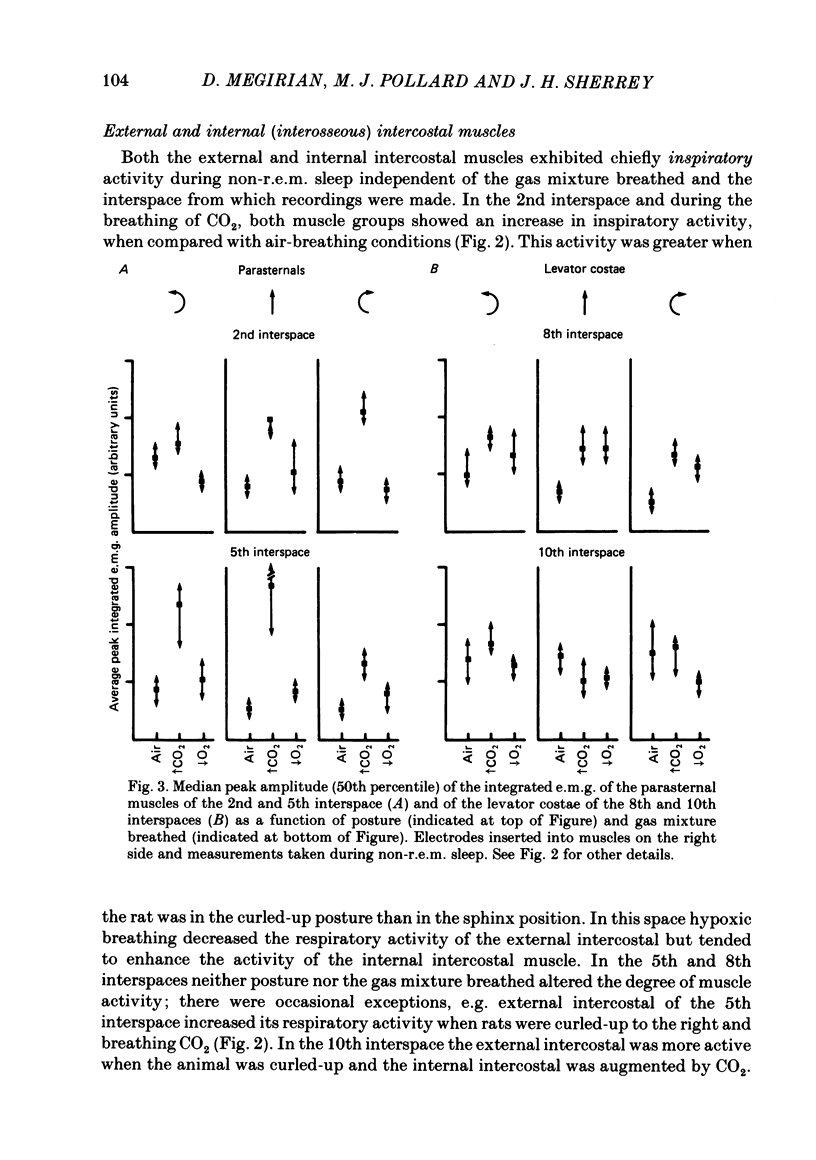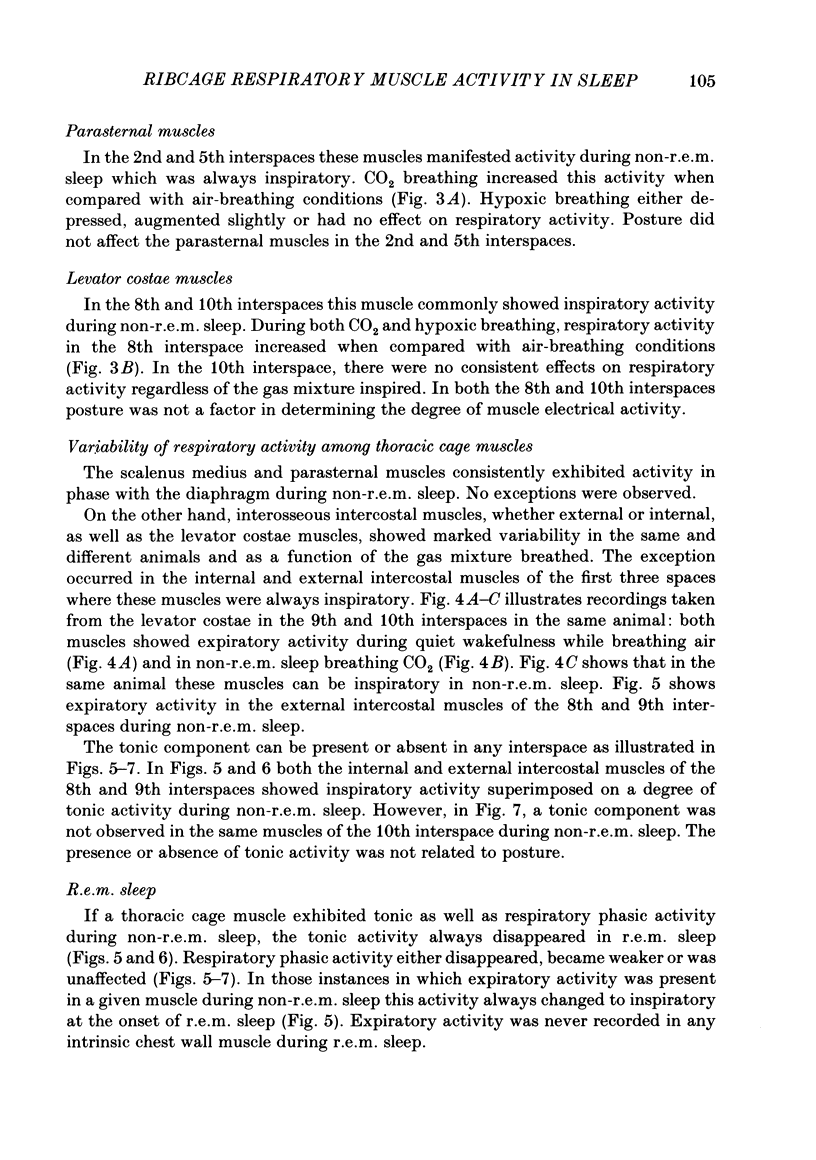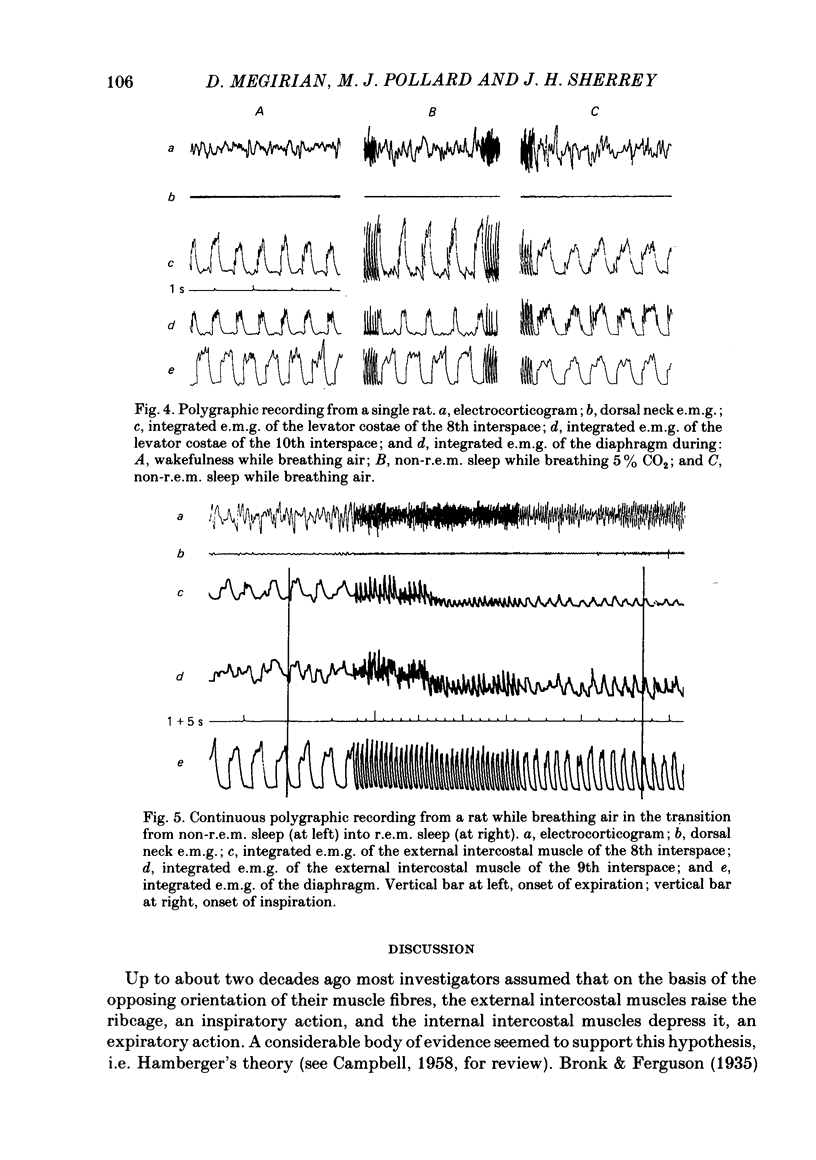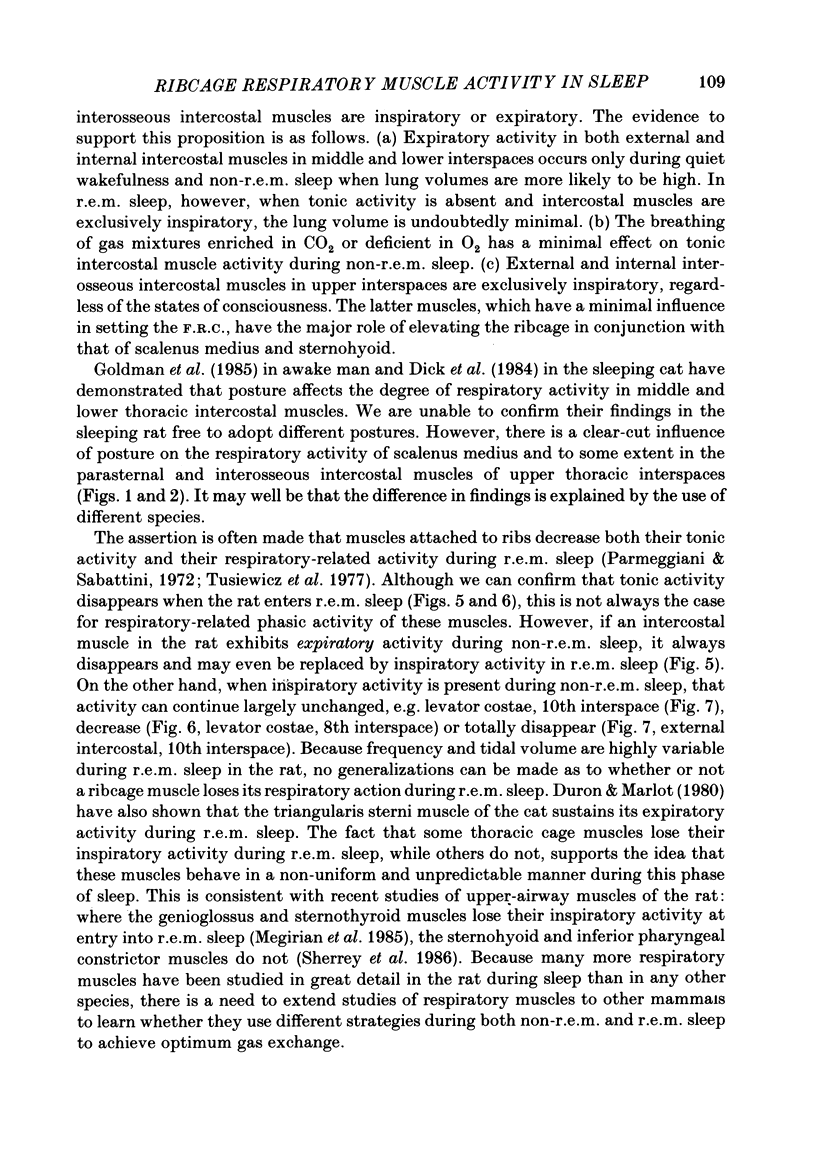Abstract
1. Sleep-waking states of chronically implanted rats were identified polygraphically while recording the integrated electromyogram (e.m.g.) of extrinsic (scalenus medius and levator costae) and intrinsic (external and internal interosseous intercostal and parasternal) muscles of the thoracic cage. Rats breathed air, air enriched in CO2 (5%) or air deficient in O2 (10% O2 in N2) and were free to adopt any desired posture. 2. In non-rapid eye movement (non-r.e.m.) sleep, the scalenus medius and intercostal muscles of the cephalic spaces were always inspiratory; intercostal muscles of the mid-thoracic spaces were commonly expiratory while the more caudal ones were only occasionally expiratory. Expiratory activity, when present in quiet wakefulness, extended for a variable period of time into non-r.e.m. sleep and always disappeared in r.e.m. sleep regardless of the ribcage muscle under study. 3. Inspiratory activity, when present in non-r.e.m. sleep, was unaffected, partially attenuated or abolished at entry into r.e.m. sleep. The peak integrated e.m.g. activity of ribcage muscles was measured as a function of posture, gas mixture breathed and ribcage site: (a) the greater the degree of curled-up posture, the greater the respiratory activity of scalenus medius, an effect augmented by CO2 but depressed by hypoxia, and (b) the more caudally placed ribcage muscles exhibited respiratory activity which was essentially unaffected by posture and gas mixture inspired. 4. The presence or absence of tonic activity in ribcage respiratory muscles during non-r.e.m. sleep was unrelated to posture. When tonic activity was present, it always disappeared in r.e.m. sleep. When expiratory activity was present in non-r.e.m. sleep, it too always disappeared in r.e.m. sleep. Inspiratory activity present in non-r.e.m. sleep was variably affected at entry into r.e.m. sleep; it was unchanged, partially attenuated or abolished. 5. It is concluded that thoracic cage muscles exhibit marked variability in their respiratory activity depending on posture, sleep-waking states and gas mixture breathed. It is postulated that the presence of tonic and/or expiratory activity in ribcage muscles during non-r.e.m. sleep reflects an increase in functional residual capacity (F.R.C.).
Full text
PDF











Selected References
These references are in PubMed. This may not be the complete list of references from this article.
- Boyd W. H. Coordinated electrical activity of diaphragm and intercostal muscles in rabbits during quiet breathing. Arch Phys Med Rehabil. 1969 Mar;50(3):127–132. [PubMed] [Google Scholar]
- Boyd W. H. The electrical activity of intercostal muscles during quiet breathing in rabbits. Can J Physiol Pharmacol. 1968 Sep;46(5):749–755. doi: 10.1139/y68-117. [DOI] [PubMed] [Google Scholar]
- Corda M., von Euler C., Lennerstrand G. Reflex and cerebellar influences on alpha and on 'rhythmic' and 'tonic' gamma activity in the intercostal muscle. J Physiol. 1966 Jun;184(4):898–923. doi: 10.1113/jphysiol.1966.sp007956. [DOI] [PMC free article] [PubMed] [Google Scholar]
- De Troyer A., Kelly S., Macklem P. T., Zin W. A. Mechanics of intercostal space and actions of external and internal intercostal muscles. J Clin Invest. 1985 Mar;75(3):850–857. doi: 10.1172/JCI111782. [DOI] [PMC free article] [PubMed] [Google Scholar]
- Dick T. E., Parmeggiani P. L., Orem J. M. Intercostal muscle activity of the cat in the curled, semiprone sleeping posture. Respir Physiol. 1984 Jun;56(3):385–394. doi: 10.1016/0034-5687(84)90072-0. [DOI] [PubMed] [Google Scholar]
- Duron B., Marlot D. Intercostal and diaphragmatic electrical activity during wakefulness and sleep in normal unrestrained adult cats. Sleep. 1980;3(3-4):269–280. doi: 10.1093/sleep/3.3-4.269. [DOI] [PubMed] [Google Scholar]
- Goldman M. D., Loh L., Sears T. A. The respiratory activity of human levator costae muscles and its modification by posture. J Physiol. 1985 May;362:189–204. doi: 10.1113/jphysiol.1985.sp015670. [DOI] [PMC free article] [PubMed] [Google Scholar]
- Hilaire G. G., Nicholls J. G., Sears T. A. Central and proprioceptive influences on the activity of levator costae motoneurones in the cat. J Physiol. 1983 Sep;342:527–548. doi: 10.1113/jphysiol.1983.sp014867. [DOI] [PMC free article] [PubMed] [Google Scholar]
- Le Bars P., Duron B. Are the external and internal intercostal muscles synergist or antagonist in the cat? Neurosci Lett. 1984 Oct 26;51(3):383–386. doi: 10.1016/0304-3940(84)90407-5. [DOI] [PubMed] [Google Scholar]
- Megirian D., Hinrichsen C. F., Sherrey J. H. Respiratory roles of genioglossus, sternothyroid, and sternohyoid muscles during sleep. Exp Neurol. 1985 Oct;90(1):118–128. doi: 10.1016/0014-4886(85)90045-7. [DOI] [PubMed] [Google Scholar]
- Megirian D., Ryan A. T., Sherrey J. H. An electrophysiological analysis of sleep and respiration of rats breathing different gas mixtures: diaphragmatic muscle function. Electroencephalogr Clin Neurophysiol. 1980 Nov;50(3-4):303–313. doi: 10.1016/0013-4694(80)90158-3. [DOI] [PubMed] [Google Scholar]
- Parmeggiani P. L., Sabattini L. Electromyographic aspects of postural, respiratory and thermoregulatory mechanisms in sleeping cats. Electroencephalogr Clin Neurophysiol. 1972 Jul;33(1):1–13. doi: 10.1016/0013-4694(72)90020-x. [DOI] [PubMed] [Google Scholar]
- Remmers J. E. Inhibition of inspiratory activity by intercostal muscle afferents. Respir Physiol. 1970 Oct;10(3):358–383. doi: 10.1016/0034-5687(70)90055-1. [DOI] [PubMed] [Google Scholar]
- SEARS T. A. THE SLOW POTENTIALS OF THORACIC RESPIRATORY MOTONEURONES AND THEIR RELATION TO BREATHING. J Physiol. 1964 Dec;175:404–424. doi: 10.1113/jphysiol.1964.sp007524. [DOI] [PMC free article] [PubMed] [Google Scholar]
- Saumarez R. C. An analysis of action of intercostal muscles in human upper rib cage. J Appl Physiol (1985) 1986 Feb;60(2):690–701. doi: 10.1152/jappl.1986.60.2.690. [DOI] [PubMed] [Google Scholar]
- Sherrey J. H., Pollard M. J., Megirian D. Respiratory functions of the inferior pharyngeal constrictor and sternohyoid muscles during sleep. Exp Neurol. 1986 Apr;92(1):267–277. doi: 10.1016/0014-4886(86)90140-8. [DOI] [PubMed] [Google Scholar]
- TAYLOR A. The contribution of the intercostal muscles to the effort of respiration in man. J Physiol. 1960 May;151:390–402. doi: 10.1113/jphysiol.1960.sp006446. [DOI] [PMC free article] [PubMed] [Google Scholar]
- Tusiewicz K., Moldofsky H., Bryan A. C., Bryan M. H. Mechanics of the rib cage and diaphragm during sleep. J Appl Physiol Respir Environ Exerc Physiol. 1977 Oct;43(4):600–602. doi: 10.1152/jappl.1977.43.4.600. [DOI] [PubMed] [Google Scholar]


